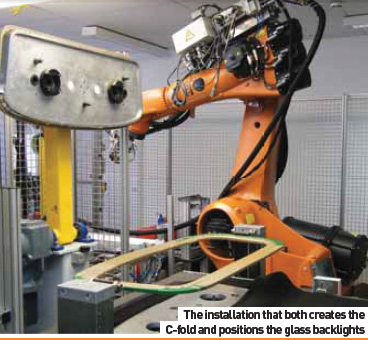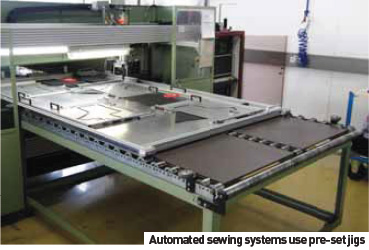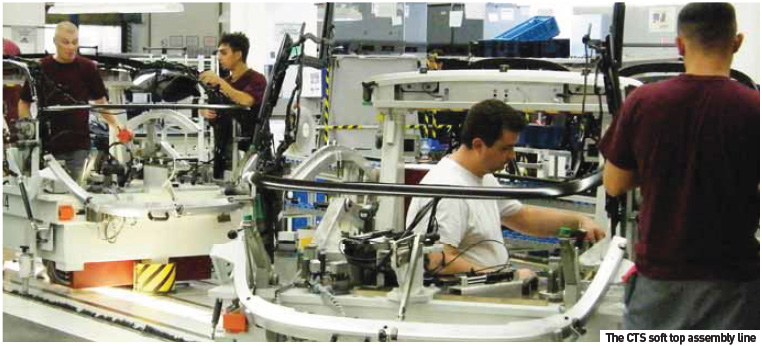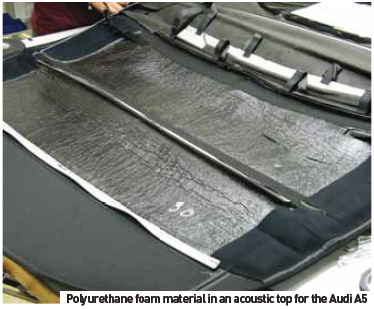
How Magna Car Top Systems in Stuttgart develops, produces and delivers convertible roof systems for OEM carmakers
Magna Car Top Systems (CTS) has a series of global production facilities, but its largest plant is located near Stuttgart, Germany in Korntal-Münchingen. The company, which became part of Magna Steyr in early 2010, produces a full range of convertible roof solutions, including hard and soft tops, together with sliding (textile) and panoramic (glass) systems. This particular location, though, concentrates on producing soft tops for a variety of customers, as Waldemar Raaz, General Manager, explains. “We have two main clients, Porsche and Audi. We have two main products for Audi, one high and one low volume, respectively for the A5 and R8. For Porsche, we have the 911 and Boxster, which are very similar in terms of volumes.” He adds that CTS also installs the backlight and interior trim for 911 hardtop models.
 In addition to delivering roof systems for Audi and Porsche models, the facility produces convertible roof assemblies for the Saab 9-3 and, in small volumes, the Mercedes G-Wagon, which is produced at the Magna Steyr facility in Graz. Having supplied tops for production of the Ferrari F430 Spyder, the company now delivers only replacement parts. “The longest delivery supply chain used to be from Stuttgart to Maranello (Italy), but it is now for Saab, since production was moved from Graz (Magna Steyr) to Trollhättan (Sweden),” says Hendrik Lötter, Global Director of Sales and Marketing.
In addition to delivering roof systems for Audi and Porsche models, the facility produces convertible roof assemblies for the Saab 9-3 and, in small volumes, the Mercedes G-Wagon, which is produced at the Magna Steyr facility in Graz. Having supplied tops for production of the Ferrari F430 Spyder, the company now delivers only replacement parts. “The longest delivery supply chain used to be from Stuttgart to Maranello (Italy), but it is now for Saab, since production was moved from Graz (Magna Steyr) to Trollhättan (Sweden),” says Hendrik Lötter, Global Director of Sales and Marketing.
Lötter says that development of a new roofing system can take between 18 and 30 months. He goes on to say that with soft top solutions there are two basic fold choices. “The Z-fold is the more complicated option, the roof opening with perhaps only a partial tonneau cover to hide the attachments. The Porsche 911 and Boxster are Z-fold examples. The other is a K-fold, which is a more conventional fold motion. The (Audi) A5 uses this method.” He continues by pointing out that the technology behind a soft top is not directly comparable to an equivalent retractable hard top due to the highly sophisticated combination of cloth and metal kinematics. “Retractable hard tops need specific know-how about sealing systems, packaging and kinematics, but the panels are comparable with standard production methods. If you look at soft tops, which bring steel and fabric together, this is a very specific knowledge area.”
Production process
The CTS facility in Korntal-Münchingen is set up over three floors. The first cutting and sewing operations are located on the first floor of the facility. “We have two automated cutting systems,” says Raaz. “There are single- and multi-ply cutting machines, which cut the cover and headliner material. The top cover is cut on the single-ply machine, as this requires a more precise cut.” He goes on to say that the machines use a blade to cut the material. Could other technologies be used to cut the material blanks? “There are other technologies, for example water jet systems. Lasers cannot be used, as the heat would distort the material edge.”
Top cover material is supplied by Haartz, a company which according to Lötter has many years of experience producing the product. “If you look closely at the material, it’s actually made up of three different layers. There’s nothing on the market that compares to Haartz fabric, it’s top quality. The ‘intelligence’ inside the material, how it stops wrinkles from appearing even after a few thousand cycles, it’s unique.” The second operation in the manufacturing process is gluing the retainers to the top cover. The adhesive is applied using a Fanuc robotic arm, which Raaz explains is able up to handle any of the roofs in production. “It has to be a very flexible system as the retainers are applied to the material in a unique way for each model. In addition to our own products, we are making parts for our plant in (Tychy) Poland.” Once arranged, dedicated equipment is used to cure the adhesive using a combination of heat and pressure. The next stage of the process is to create a C-fold in the backlight area of the top cover. For this, the edge of the material is cut into small sections, adhesive is applied and a frame is forced through to fold over and hold the material. It is a completely automated process, with the adhesive applied by a Kuka robot. On the other side of this machine, the glass is applied to the top cover, the equipment holding the completed part until the adhesive (applied by the same robot) has cured. “The temperature and humidity in the room is carefully controlled,” says Raaz, “as the adhesive, supplied by Forbo, requires precise curing conditions.”
 All back windows in roofs produced by CTS are currently made of glass, though this might change in the future. Lötter: “In the past, there were many examples using polycarbonate, but the material was not reliable enough. Today, following advances in the technology that allow addition of a heater element and improved scratch-resistance, we are again discussing using the material. It would help with weight saving – we are in business to make a lightweight product - but it will take some time to develop this technology.” On the second floor, the primary activity is sewing the headliners and top covers together on lines dedicated to producing tops for an individual OEM. At the end of each line is a testing area to assess product quality. In addition to two automated sewing platforms, production also uses standard sewing machines fitted with jigs to reproduce small sewing patterns, but Raaz says that if the work is not carried out by either of these, it is performed by hand. “The sewing platforms add the headliner insert, which otherwise would be a very time-consuming process. Also, doing this process manually produces more scrap material.”
All back windows in roofs produced by CTS are currently made of glass, though this might change in the future. Lötter: “In the past, there were many examples using polycarbonate, but the material was not reliable enough. Today, following advances in the technology that allow addition of a heater element and improved scratch-resistance, we are again discussing using the material. It would help with weight saving – we are in business to make a lightweight product - but it will take some time to develop this technology.” On the second floor, the primary activity is sewing the headliners and top covers together on lines dedicated to producing tops for an individual OEM. At the end of each line is a testing area to assess product quality. In addition to two automated sewing platforms, production also uses standard sewing machines fitted with jigs to reproduce small sewing patterns, but Raaz says that if the work is not carried out by either of these, it is performed by hand. “The sewing platforms add the headliner insert, which otherwise would be a very time-consuming process. Also, doing this process manually produces more scrap material.”
He adds that the facility is currently undergoing a fundamental change in how production is arranged, based on the newly-adopted CTS Production System. “Historically, we had a system where just a certain production amount was expected per day. But we have started to balance the line and adjusted quotas accordingly. We have had a good experience with this at our Polish facility, where the line is now balanced. Lötter: “We use a state-of-the-art system. Our plants in Tychy (Fiat 500), Mülheim (Peugeot 308CC) and Bremen (Mercedes-Benz SL-Class, SLK), are completely set up. Here, we are still looking to create clearways for the inbound logistics; the idea is to run the assembly line through the logistics area.”
Final assembly
The completed covers are delivered by elevator to the ground floor, where the final assembly processes are carried out  on a conveyored line consisting of nine stations. Various preassembly operations are carried out off the line, including the addition of individual bow elements, held in place by the glued-in retainers. “The bows connect the left- and righthand kinematics,” says Raaz. “They also support the roof and stop the top from ballooning up when the vehicle is at speed. Unlike other roof systems, our tops are designed for high speed, cars do need to have speed limiters.”
on a conveyored line consisting of nine stations. Various preassembly operations are carried out off the line, including the addition of individual bow elements, held in place by the glued-in retainers. “The bows connect the left- and righthand kinematics,” says Raaz. “They also support the roof and stop the top from ballooning up when the vehicle is at speed. Unlike other roof systems, our tops are designed for high speed, cars do need to have speed limiters.”
Another pre-assembly is adding the closed, oil-filled hydraulic system, which Lötter points out is the most expensive individual part of the roof system. “The mechanism represents between 15 and 25% of the total value of the top.” He goes on to say that only two companies are able to supply these hydraulic units: PowerPacker, based in the Netherlands, and Hörbiger in Germany. Based on the weight of the top, the anticipated number of operations, and other actions that can include operation of a tonneau cover, the selected supplier then develops a pump to supply the exact pressure and force to suit each project.
Operating noise of the hydraulics is also key to the user experience. “Noise (related to the pump) is not an issue with lower-price cars, but in premium vehicles the hydraulic unit is encased in either polyurethane foam or a largely recycled material to dampen the noise.” Only one current CTS roof system, produced for the Porsche Boxster, features an electric roof system. Lötter says that the decision to use this solution was driven by the need for design flexibility – specifically, the removal of linkage systems typically used with hydraulic systems.
Unlike production of convertible roofs for the Audi A5, which are manufactured on a short assembly line, Magna Car Top Systems (CTS) takes a different approach when building tops for the Audi R8 Spyder. “On the R8 line, each stage of production is completed on a single buck,” says Hendrik Lötter, Global Director of Sales and Marketing at Magna CTS. The facility produces between eight and 10 units per day, which are delivered just-in-sequence to the Audi R8 production facility in Ingolstadt, Germany, about two hours from the plant. “It is important that they are delivered just-in-sequence, as we also supply the tonneau cover, which is a bodycolour match for each car,” explains Lötter. The finished module can be bolted to the BIW, complete with rollover bars and a retractable backlight element, which offers an appreciable time savings on the assembly line. A hand-held laser scanning device is passed over the finished assembly to check tolerances, the results displayed on a flat screen monitor. “There are a series of measurement points on the top, and we supply each one with this data. We guarantee 100% of all R8 roofs that we deliver will meet required specification.”
The completed roof assembly is then loaded on a buck for the final assembly processes, which include the addition of left and right kinematics, essentially the roof ’s rear hinges, which are operated by the hydraulic system. “The kinematics are made to a Magna design,” says Raaz. “The stamped components are purchased from a supplier and the (unit) assembly is done by an affiliated company, which also carries out the electrocoating process.” The kinematics, says Lötter, are constructed using parts made of steel, aluminium, magnesium and plastic. To save weight, some parts used in the kinematics are produced using thixomoulding, a type of injection moulding. “Using an aluminium and magnesium mix, we are able to save between 20 and 40% in weight over steel. Also, part thickness is reduced to only 0.5mm.” A measurement station is integrated into the final assembly process, which Raaz says can provide vital data if there are issues on the OEM assembly line. “We store the (measurement) data, as if there is a variance in the BIW measurements, we can trace to see if it is the car body or roof that is the wrong size. The data can help determine the root cause of the problem.”
If the roof does not meet pre-set benchmark measurements, it can be adjusted in a dedicated rework area. Raaz points out that as the line is balanced, an individual unit cannot be taken back to a station for adjustment. Overall, he says that the target first-time pass through rate is 90%. As individual parts can be replaced, only a very small number of units have to be scrapped.
Raaz goes on to say that he also has to balance production with regards to varying seasonal output. “We are now working one shift, but in spring we typically start to work two shifts.” Considering the required skill set, is it difficult to staff the second shift? “It can be a challenge, as we demand certain qualifications and a high level of commitment. Although the manual operations are quite sophisticated, no mistakes are allowed.” Production at CTS is performed in batches as the bucks need to be set up for individual roof systems. Volume production, says Raaz, is currently dedicated to the Audi A5. “The model is offered with a base line and also an acoustic top. The difference between the two is a layer of PU foam in the roof cover.” He points out that the addition can reduce interior cabin noise to levels equalling those of the equivalent coupe model. The foam is supplied by Parat, which installs the product at their own facility and then ships the tops back for final assembly. Raaz describes the foam as having ‘memory’ properties, as it must regain its original shape after each roof operation or lose its effectiveness. Despite the benefits, he estimates that the installed foam adds 15% to the total build cost of an individual roof system.
“The roofs are delivered just-in-sequence to the Audi plant,” says Lötter. “When we start production of a new model, we have our people present at the facility for at least three months – there are always minor changes that must be made.” He goes on to explain the OEM assembly line also features what is called a ‘spider’ fixture, a handling device developed to assist in roof installation on the OEM production line.
Possible savings
Considering the location of Magna Car Top Systems in one of the highest-wage areas in Europe, and the company’s reliance on manual labour, could the company benefit from switching to a region that offered lower labour rates? “When we are setting up a new business case, we always check and calculate different scenarios. This includes scenarios where all or part of the operation is relocated to areas with lower wages.” Yet Raaz is quick to qualify the results of this research. “We have to balance these findings with our location here in Stuttgart, we are very close to our customers - we’re delivering roofs just-in-sequence to Audi.” Further, he explains that although other areas might offer a reduced wage bill, any gains in this area could be off-set by any increased logistics costs. “We have a high commitment to our skilled workforce in Germany,” he points out. Costs could also be reduced by sourcing parts in regions outside Europe, primarily focusing on China “We have looked to reduce costs by approaching companies in China to enlarge our global supplier base.” Further to this, the company would have to overcome the local preference for panoramic roof systems which allow light in but keep dust out.
As a Tier 1 supplier, Lötter says that CTS is sandwiched between OEMs and their own part suppliers. “The volume risk is what really hurts. Most of the OEMs put the volume risk on our side. So we invest millions of euros to develop piece parts, but if the volumes drop we will never be amortized for our investment.” Further, he points out that irrespective of volumes, Magna’s suppliers are looking for full reimbursement based on the original volume planning, which puts CTS in the unenviable position of having to negotiate with the OEM and the supply base.
Lötter closes by saying that currently, business at CTS is doing well. “Combined with the repeatable, quantifiable technology, there are elements to producing convertible tops, the way the material interacts with the various mechanisms, that can only be understood through extensive experience. Although there is a trend for OEMs to take operations back in-house, we think that due to the very steep learning curve and the need to maintain overall quality, we will remain as a supplier of convertible roof top systems to OEMs.”




























